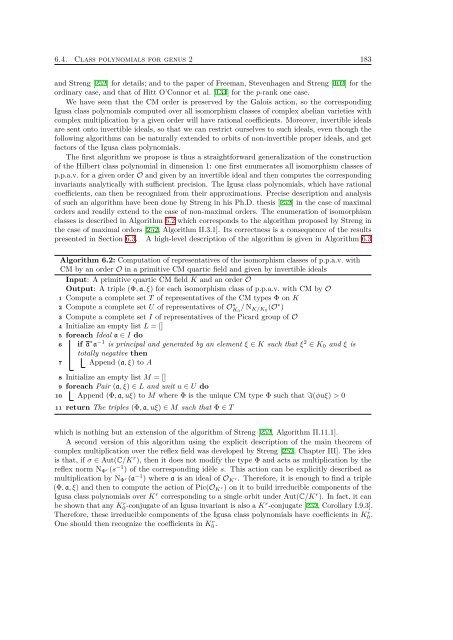here - Sites personnels de TELECOM ParisTech - Télécom ParisTech
here - Sites personnels de TELECOM ParisTech - Télécom ParisTech
here - Sites personnels de TELECOM ParisTech - Télécom ParisTech
Create successful ePaper yourself
Turn your PDF publications into a flip-book with our unique Google optimized e-Paper software.
6.4. Class polynomials for genus 2 183and Streng [252] for <strong>de</strong>tails; and to the paper of Freeman, Stevenhagen and Streng [102] for theordinary case, and that of Hitt O’Connor et al. [134] for the p-rank one case.We have seen that the CM or<strong>de</strong>r is preserved by the Galois action, so the correspondingIgusa class polynomials computed over all isomorphism classes of complex abelian varieties withcomplex multiplication by a given or<strong>de</strong>r will have rational coefficients. Moreover, invertible i<strong>de</strong>alsare sent onto invertible i<strong>de</strong>als, so that we can restrict ourselves to such i<strong>de</strong>als, even though thefollowing algorithms can be naturally exten<strong>de</strong>d to orbits of non-invertible proper i<strong>de</strong>als, and getfactors of the Igusa class polynomials.The first algorithm we propose is thus a straightforward generalization of the constructionof the Hilbert class polynomial in dimension 1: one first enumerates all isomorphism classes ofp.p.a.v. for a given or<strong>de</strong>r O and given by an invertible i<strong>de</strong>al and then computes the correspondinginvariants analytically with sufficient precision. The Igusa class polynomials, which have rationalcoefficients, can then be recognized from their approximations. Precise <strong>de</strong>scription and analysisof such an algorithm have been done by Streng in his Ph.D. thesis [252] in the case of maximalor<strong>de</strong>rs and readily extend to the case of non-maximal or<strong>de</strong>rs. The enumeration of isomorphismclasses is <strong>de</strong>scribed in Algorithm 6.2 which corresponds to the algorithm proposed by Streng inthe case of maximal or<strong>de</strong>rs [252, Algorithm II.3.1]. Its correctness is a consequence of the resultspresented in Section 6.3. A high-level <strong>de</strong>scription of the algorithm is given in Algorithm 6.3Algorithm 6.2: Computation of representatives of the isomorphism classes of p.p.a.v. withCM by an or<strong>de</strong>r O in a primitive CM quartic field and given by invertible i<strong>de</strong>alsInput: A primitive quartic CM field K and an or<strong>de</strong>r OOutput: A triple (Φ, a, ξ) for each isomorphism class of p.p.a.v. with CM by O1 Compute a complete set T of representatives of the CM types Φ on K2 Compute a complete set U of representatives of O ∗ K 0/ N K/K0 (O ∗ )3 Compute a complete set I of representatives of the Picard group of O4 Initialize an empty list L = []5 foreach I<strong>de</strong>al a ∈ I do6 if a ∗ a −1 is principal and generated by an element ξ ∈ K such that ξ 2 ∈ K 0 and ξ istotally negative then7 Append (a, ξ) to A8 Initialize an empty list M = []9 foreach Pair (a, ξ) ∈ L and unit u ∈ U do10 Append (Φ, a, uξ) to M w<strong>here</strong> Φ is the unique CM type Φ such that I(φuξ) > 011 return The triples (Φ, a, uξ) ∈ M such that Φ ∈ Twhich is nothing but an extension of the algorithm of Streng [252, Algorithm II.11.1].A second version of this algorithm using the explicit <strong>de</strong>scription of the main theorem ofcomplex multiplication over the reflex field was <strong>de</strong>veloped by Streng [252, Chapter III]. The i<strong>de</strong>ais that, if σ ∈ Aut(C/K r ), then it does not modify the type Φ and acts as multiplication by t<strong>here</strong>flex norm N Φ r(s −1 ) of the corresponding idèle s. This action can be explicitly <strong>de</strong>scribed asmultiplication by N Φ r(a −1 ) w<strong>here</strong> a is an i<strong>de</strong>al of O K r. T<strong>here</strong>fore, it is enough to find a triple(Φ, a, ξ) and then to compute the action of Pic(O K r) on it to build irreducible components of theIgusa class polynomials over K r corresponding to a single orbit un<strong>de</strong>r Aut(C/K r ). In fact, it canbe shown that any K r 0-conjugate of an Igusa invariant is also a K r -conjugate [252, Corollary I.9.3].T<strong>here</strong>fore, these irreducible components of the Igusa class polynomials have coefficients in K r 0.One should then recognize the coefficients in K r 0.
















